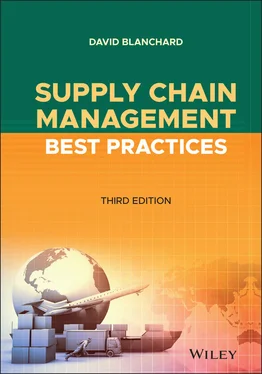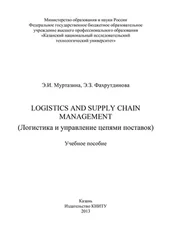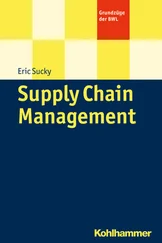7 They have a global, rather than regional, focus. 1
In short, the best-run organizations have developed world-class supply chains that extend from their customers' customers to their suppliers' suppliers, and all points in between. As this chapter illustrates, many of the best practices of one industry can be tweaked so that they'll work for another industry as well.
Best practices tell only part of the story, though. For one thing, best practices are not etched in stone. Thanks to advances in technology and changes in customer expectations, what might have been considered best-in-class not that long ago (for instance, next-day delivery) is now considered as a standard option for delivering products to customers, and if 3D printing technology continues to evolve, instant (or almost instant) delivery could become not only achievable but routine. The best practices in this chapter, then, are meant to provide a flavor for what companies have done and are doing to expand the possibilities of supply chain management, but they're certainly not meant to be the last word.
What's undeniable is that behind every successful supply chain organization is a team of dedicated and influential change agents. Or, to put it more simply, a supply chain wins or loses based on the quality of the people who manage it. With that in mind, let's look at some of the most innovative efforts at supply chain management in several industries and at some of the people who have spearheaded their companies' best practices efforts.
Aerospace: Changing the Game, for Better or Worse
It's only fitting that we should start by looking at the Boeing Co., as the aerospace giant's 787 Dreamliner project is not only a game changer when it comes to pushing the boundaries of what's possible with a fully connected supply chain, but it's also an example of what can go wrong when a company's supply chain reach exceeds its grasp.
Boeing's goal with the Dreamliner was nothing short of evolutionary: Rather than merely talking about an extended enterprise that involved key partners in every step along the supply chain, Boeing would actually do it. Namely, Boeing the airplane maker would become Boeing the airplane assembler, outsourcing the entire production of its new aircraft to suppliers, and then finishing the plane at the final assembly stage. On the face of it, that doesn't sound radically different from what the major automakers do, locating Tier 1 suppliers in close proximity to the assembly plants. However, while an automobile might be built with as many as 8,000 to 10,000 parts, an airplane might have three million parts or more.
In addition, while in the past Boeing had used outside suppliers to build roughly 50% of its planes, its plan for the Dreamliner was to outsource 70% of its fabrication, with much of the major components coming from outside the United States. Engines, for instance, would come from both Ohio and the UK; wingtips from Korea; trailing edges from Australia and Japan; center fuselages from Italy; cargo access doors from Sweden; and passenger entry doors from France. In fact, Boeing went so far as to develop a cargo plane—the Dreamlifter—to transport the larger parts, such as wings and fuselage, to the final assembly plant in Everett, Washington. 2
The reason for outsourcing so much of the production work is the realization that the best process skills in aerospace oftentimes lie outside Boeing's factories, says Mike Bair, former head of the Dreamliner program. The new plane would involve not only a new supply chain plan, but also the development of lightweight composite materials and fuel-efficient engines, new production processes, and an interior architecture that would set new standards for passenger comfort. The Dreamliner became the fastest-selling commercial aircraft in history, based on preorders. However, orders do not necessarily mean deliveries. 3
Due to numerous setbacks and supply chain problems, Boeing was not able to deliver any Dreamliners by its initial target date of May 2008. Nor were they able to fill any orders in 2009, or 2010. As it turned out, the first 787 wasn't delivered to a customer until September 2011. The company admitted that it was “more difficult than we anticipated to complete the structural work on the airplane out of sequence in our Everett factory.”
In The Supply-Based Advantage , consultant Stephen C. Rogers explains that the never-ending delays weren't due to a flawed supply chain strategy; instead, it was the unprecedented nature of the project itself that led to the problems. “The supply chain structure for the Dreamliner took best-in-class supply chain thinking and applied it from the design phase through to production,” he observes. However, “the scale and scope of the task was enormous when considering the sheer number of parts, amount of innovation, number of subcontracting tiers, and geographical dispersion of the contractors. No company ever managed such a project before.” Since nearly three-quarters of the work was being done by suppliers, naturally most of the production problems were on the supplier end as well, and as Boeing quickly discovered, a game-changing initiative like the Dreamliner requires extreme supply chain management.
In response, Boeing instituted a more intense supplier support and monitoring system to address breakdowns in the supply chain. Rogers points out, “The key [for Boeing] is to manage what counts and find ways to extend resources through the use of suppliers. This is easier said than done since many Tier 2 and Tier 3 suppliers have allegiance to the Tier 1 supplier, not the company that is buying the chain's combined output. Why? Because the relationship is typically tier to tier, not across multiple tiers.” 4
Assessing Boeing's troubles launching the Dreamliner, consultant Suman Sarkar observes that by distributing the production of the aircraft across numerous countries, Boeing found itself facing various language, culture, and coordination challenges—and these challenges were compounded by Boeing's engineers making multiple design changes at a moment's notice. “Unless a supplier had worked with Boeing before, it became difficult for suppliers to manage this constant change philosophy,” Sarkar says. “Implementing change takes time when you are working with suppliers in different parts of the world. In a rush to meet the deadline for launch, corners were sometimes cut, which resulted in post-launch problems.” 5
Ultimately, the aerospace giant ended up acquiring some of its key suppliers, which increased Boeing's involvement in the production stages by transforming its outsourcers into in-house providers. As a result, the company's reliance on a very old-fashioned (but time-tested) best practice—buying out a supplier—trumped its game-changing strategy. While Boeing is still dogged by quality problems (exacerbated, according to a 2019 New York Times investigation, by “a culture that often values production speed over quality”), 6 the company has succeeded in upping its monthly production of Dreamliners to 14.
Consumer-Packaged Goods: The Moment of Truth
There is a defining moment of truth for every customer who enters a retail store, and it comes when the customer selects a specific product for purchase. If there is one thing retailers and their consumer packaged goods (CPG) suppliers fear more than anything else, it's the dreaded empty shelf. When you consider that the out-of-stock rate for retailers averages around 10%, there's a lot of money not being spent by frustrated consumers.
When Procter & Gamble Co. formed its Consumer-Driven Supply Network, it set some lofty goals for its supply chain transformation efforts: reduce inventory by 50%, trim out-of-stocks by 50%, and achieve 20% savings in logistics costs. Reaching those goals required addressing such key areas as product availability, shelf quality, and on-time delivery.
Читать дальше












